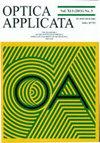投影响应计算的同时强度投影及其在主动辐射定标中的应用
IF 0.5
4区 物理与天体物理
Q4 OPTICS
引用次数: 0
摘要
数字条纹投影(DFP)系统中最重要的误差来源之一是投影器在使用三步相位恢复算法时的响应非线性。因此,有必要在不影响效率的前提下提高精度。在这个意义上,采用了辐射整流方法。提出了一种用于数字条纹投影的主动辐射校正方法。该方案在传统有源技术的基础上进行了两方面的改进:一是采用平行强度投影,仅需4个点模式即可获得投影响应;其次,给出了一种计算保证投影响应对称的逆多项式的方法。在数字条纹投影系统中的实验结果表明,采用该方法后,相位均方根误差提高了6.3倍。本文章由计算机程序翻译,如有差异,请以英文原文为准。
Simultaneous intensity projection for projector response computation with application to an active radiometric calibration
One of the most important sources of errors in digital fringe projection (DFP) systems is the nonlinearity in the response of the projector when it uses the three-step phase retrieval algorithm. Thus, it is necessary to increase the accuracy without affecting the efficiency. In this sense, the radiometric rectification methods are used. In this paper, an active radiometric rectification method for digital fringe projection is proposed. This proposal consists in two improvements of traditional active techniques: first, parallel intensity projection is used to obtain the projector response which requires only four dot patterns; and second, a method is provided for the calculation of the inverse polynomial that guarantees symmetry with respect to the response of the projector. Experimental results, in a digital fringe projection system, show that the root-mean-square phase error improves 6.3 times using this proposal.
求助全文
通过发布文献求助,成功后即可免费获取论文全文。
去求助
来源期刊

Optica Applicata
物理-光学
CiteScore
1.00
自引率
16.70%
发文量
21
审稿时长
4 months
期刊介绍:
Acoustooptics, atmospheric and ocean optics, atomic and molecular optics, coherence and statistical optics, biooptics, colorimetry, diffraction and gratings, ellipsometry and polarimetry, fiber optics and optical communication, Fourier optics, holography, integrated optics, lasers and their applications, light detectors, light and electron beams, light sources, liquid crystals, medical optics, metamaterials, microoptics, nonlinear optics, optical and electron microscopy, optical computing, optical design and fabrication, optical imaging, optical instrumentation, optical materials, optical measurements, optical modulation, optical properties of solids and thin films, optical sensing, optical systems and their elements, optical trapping, optometry, photoelasticity, photonic crystals, photonic crystal fibers, photonic devices, physical optics, quantum optics, slow and fast light, spectroscopy, storage and processing of optical information, ultrafast optics.
 求助内容:
求助内容: 应助结果提醒方式:
应助结果提醒方式:


